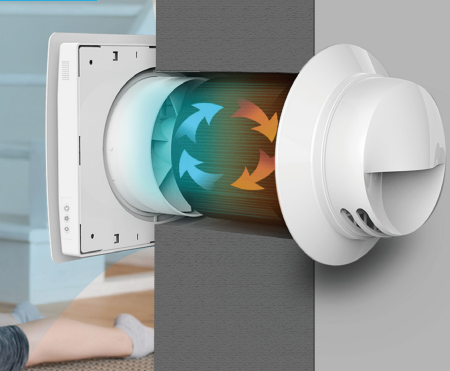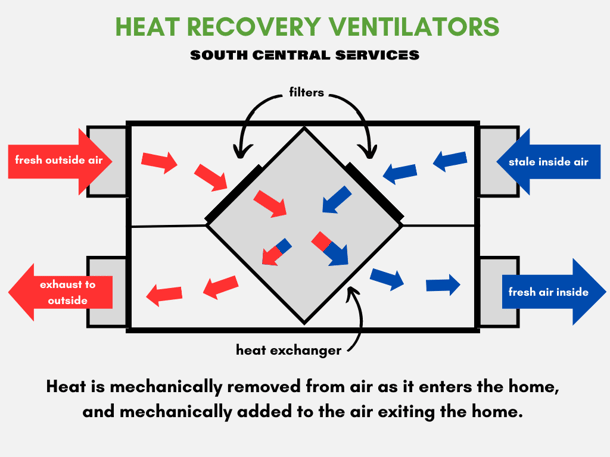Top Strategies to Clean Your HRV System
Wiki Article
Revealing the Trick Advantages and Uses of Heat Recovery Ventilation in Sustainable Style
Heat Recovery Ventilation (HRV) systems play an essential role in sustainable style. They assist in a continuous exchange of stale interior air with fresh outside air, substantially boosting indoor air high quality. Additionally, HRVs add to power performance by recovering warmth from worn down air, which can reduce energy costs. Comprehending the complex advantages and applications of HRVs exposes their value in modern architecture. What other advantages do these systems supply in the search of sustainability?Understanding Heat Recovery Ventilation Systems
Heat recovery ventilation (HRV) systems are created to boost indoor air high quality while minimizing energy loss. These systems use a mechanical air flow approach to exchange stagnant indoor air with fresh outdoor air, making certain a continual supply of tidy air. By capturing warm from the exhaust air, HRVs prerequisite inbound air, decreasing the need on home heating and cooling systems. This procedure not just improves thermal comfort however likewise adds to power performance in household and industrial structures. In addition, HRV systems assist control humidity degrees and reduce indoor pollutants, advertising a much healthier living atmosphere. Their tactical implementation is necessary for achieving lasting style goals, as they provide a balance between power preservation and passenger well-being.Exactly How HRV Solution Job
While many may know with air flow systems, comprehending exactly how heat healing ventilation (HRV) systems run is crucial for valuing their advantages. HRV systems work by trading stagnant indoor air with fresh exterior air while moving heat between the 2 streams. This procedure takes place in a warm exchanger, where warm from the outward bound air warms the inbound air throughout colder months, lessening energy loss. Conversely, in warmer months, the system can cool inbound air using the cooler outbound air. HRVs are geared up with fans to promote air flow and filters to remove particulates, making sure a continuous, balanced ventilation procedure. This innovative layout not just boosts energy effectiveness however additionally adds to preserving a comfy interior setting.Enhancing Indoor Air High Quality
Indoor air quality can substantially impact wellness and well-being, making reliable ventilation important in modern-day homes. Heat Recovery Ventilation (HRV) systems play a vital duty in preserving interior air high quality by continuously exchanging stagnant interior air with fresh outside air. This process not just lowers airborne pollutants however also minimizes humidity degrees, which can bring about mold and mildew growth and respiratory system concerns. HRV systems filter inbound air, getting rid of allergens and particulates, thereby offering a much healthier living environment. In addition, these systems help get rid of smells and volatile natural compounds (VOCs) generally discovered in house items. By ensuring a consistent flow of clean air, HRV systems contribute to a general better interior environment, advertising comfort and health for owners.Energy Performance and Price Savings
Energy effectiveness attracts attention as a considerable benefit of Heat Recovery Ventilation (HRV) systems. By catching and recycling the warmth from tired interior air, HRVs minimize the power required for home heating incoming fresh air, resulting in reduced power consumption. This effectiveness converts into lower utility expenses, supplying considerable price financial savings for house owners and services alike. In addition, HRV systems typically qualify for energy efficiency rewards and discounts, better enhancing their economic appeal. With time, the first investment in HRV innovation can bring about a desirable roi via lowered energy expenses. Subsequently, the assimilation of HRV systems not just advertises sustainable style however additionally provides a functional remedy for attaining long-lasting energy savings and financial benefits.Ecological Benefits of HRV

A wide range of ecological advantages occurs from the implementation of Heat Recovery Ventilation (HRV) systems. By efficiently transferring warmth from exhaust air to inbound fresh air, HRVs considerably decrease the energy required for heating and cooling rooms. This power efficiency converts to reduce greenhouse gas emissions, adding to a decline in the total carbon impact of structures. Additionally, HRV systems improve interior air quality by continually distributing fresh air, thereby reducing the concentration of indoor pollutants and allergens. Additionally, the reduction in energy intake aids in conserving natural sources, making HRVs a vital element of sustainable style. On the whole, the environmental advantages of HRVs play an essential role in promoting a healthier planet and fostering environmentally friendly structure techniques.
Versatile Applications in Modern Style
Heat recovery ventilation (HRV) systems are increasingly being incorporated into both domestic and find here business architectural projects. In domestic setups, HRVs boost indoor air top quality while taking full advantage of power performance. Meanwhile, in commercial rooms, these systems maximize air flow methods, showing their adaptability in contemporary architectural applications.Residential Projects Integration
While modern architecture increasingly stresses sustainability, the integration of warm healing ventilation systems in residential projects has become a functional option for boosting indoor air top quality and power efficiency. These systems efficiently move warm from exhaust air to inbound fresh air, lessening energy loss and decreasing heating or cooling down demands. In brand-new builds and retrofits alike, warmth recovery ventilation can be perfectly integrated, providing homeowners with a healthier living environment while lowering energy costs. In addition, with increasing understanding of environmental impacts, more engineers and home builders are acknowledging the lasting advantages of these systems. As an outcome, warm healing air flow has come to be a crucial part of sustainable residential design, showcasing adaptability and commitment to green practices.Commercial Rooms Optimization
As modern commercial spaces advance to fulfill the demands of sustainability and performance, the application of heat healing air flow systems becomes a key technique for maximizing indoor environments. These systems facilitate the exchange of stagnant interior air with fresh outside air while recovering heat, substantially minimizing power usage. This not just improves comfort for residents yet additionally assists in reducing functional costs. Functional applications can be observed in offices, retail spaces, and schools, where air quality and temperature level control are critical. Additionally, incorporating warmth recovery ventilation lines up with eco-friendly building certifications, further advertising ecological responsibility. Inevitably, taking on such systems in business design not only adds to sustainability objectives however additionally promotes healthier, a lot more effective spaces for individuals.
Integrating HRV Into Sustainable Style Practices
Incorporating warmth recovery air flow (HRV) systems right into sustainable layout techniques offers considerable benefits in energy effectiveness and indoor air top quality. By using HRV, developers can produce affordable remedies that not only reduce energy intake yet also enhance the general convenience of interior atmospheres. This positioning with sustainability goals settings HRV as a crucial element in modern-day building strategies.
Energy Performance Enhancement
By incorporating warmth recuperation ventilation (HRV) systems into lasting layout practices, architects and builders can substantially improve power performance in contemporary constructions. HRV systems operate by recording warmth from outgoing stagnant air and transferring it to incoming fresh air, decreasing the power needed for home heating or cooling indoor areas. This process not only lowers reliance on conventional cooling and heating systems but additionally lowers overall power intake. Additionally, HRV systems can help preserve a constant interior temperature, decreasing peak energy needs. By integrating these systems, structures can accomplish substantial decreases in utility prices and carbon impacts, lining up with sustainability objectives. Eventually, HRV technology represents a practical service for enhancing power efficiency in the developed setting, advertising more responsible source use.Indoor Air Quality Improvement
Exactly how can warmth recuperation air flow (HRV) systems contribute find to premium indoor air top quality in modern-day buildings? HRV systems successfully exchange stale interior air with fresh outdoor air while recovering warm power, lessening temperature variations. This procedure decreases the concentration of indoor toxins, such as unpredictable natural substances (VOCs), irritants, and moisture, which can weaken air high quality and impact resident health and wellness. By keeping excellent moisture levels and making sure a continuous supply of clean air, HRVs aid produce a healthier indoor environment. Additionally, these systems can be integrated right into lasting layout methods, advertising energy effectiveness along with enhanced air quality. HRV Heat Recovery Ventilation. Subsequently, HRV technology plays an important role ahead of time general resident convenience and well-being in contemporary architectural designsCost-Effective Layout Solutions

Frequently Asked Questions
What Maintenance Is Required for Heat Recovery Ventilation Equipments?

Maintenance for warmth recovery air flow systems typically includes routine filter substitutes, cleaning of heat exchangers, assessment of fans and air ducts, and guaranteeing correct drain. These tasks assist preserve efficiency and prolong the system's lifespan gradually.
Can HRV Systems Be Mounted in Existing Structures?
Heat recovery ventilation systems can certainly be set up in existing buildings. HRV Heat Recovery Ventilation. Retrofitting requires careful planning and assessment of the structure's format, ensuring compatibility with current systems while optimizing energy performance and indoor air top qualityJust How Do HRV Systems Impact Noise Levels Inside Your Home?
HRV systems can influence indoor sound degrees by presenting sound from exterior sources with ventilation. However, high-quality installments commonly include sound-dampening functions, reducing noise effect while offering reliable air exchange and maintaining comfort inside your home.Are There Any Disadvantages to Making Use Of HRV Equipments?
The drawbacks of using HRV systems include potential high first costs, upkeep difficulties, and the possibility of decreased indoor air quality if filters are sporadically altered, which might bring about issues with moisture degrees.Just how Do I Select the Right HRV System for My Requirements?
Choosing the appropriate warm healing ventilation system includes assessing details needs, such as building dimension, environment, and power efficiency objectives. In addition, evaluating system attributes, installation requirements, and maintenance factors to consider is vital for peak performance and fulfillment.Report this wiki page